HP ZR30w Versus DoubleSight DS-309W, 30-Inch Monitors, Tested
With a steady stream of 27-inch QHD monitors coming through our lab, we thought we’d take a quick break and test two even bigger screens, the 30-inch, 16:10 aspect ratio HP ZR30w and DoubleSight DS-309W. How do these $1000+ stunners compare?
Results: Stock Brightness And Contrast
Before calibrating both panels, we measure zero and 100 percent signals at both ends of the brightness control range. This shows us how contrast is affected at the extremes of a monitor's luminance capability. In DoubleSight’s case, we used the contrast control to manipulate the light output.
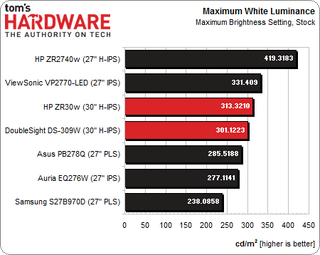
At over 300 cd/m2, both panels offer more than enough light output for any work environment. The HP was set to maximum brightness while the DoubleSight display had its contrast set to the highest possible value without clipping detail. While you could increase its output to around 375 cd/m2, the image would be so lacking in detail that it wouldn't be usable.
More and more panels today have LED backlights, but these two still use CCFL. Let’s see how that affects the black level.
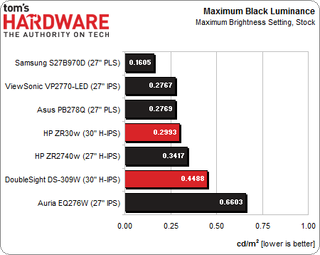
The HP falls to the middle of the pack, while the DoubleSight fares somewhat worse. It might be said that LED backlighting provides a superior black level, but our results show this is not always true. Both the HP ZR2740w and the Auria EQ276W utilize LEDs.
With both monitors close in max brightness, the black level is what determines the final contrast ratio.

The ZR30w manages to crack the 1000:1 barrier, but the DS-309W is 34 percent lower at 670.9:1. This is a fair result, and it’s still ahead of the Auria. To our eyes, both panels display a decent image with good punch and detail. To put the contrast-winning Samsung on your desk, you’ll pay around the same price and give up 33 percent of your screen area.
To measure the minimum brightness levels, we turned down the HP’s one and only adjustment, brightness control. On the DoubleSight, we left the brightness alone and reduced the contrast to its lowest setting.
Stay on the Cutting Edge
Join the experts who read Tom's Hardware for the inside track on enthusiast PC tech news — and have for over 25 years. We'll send breaking news and in-depth reviews of CPUs, GPUs, AI, maker hardware and more straight to your inbox.
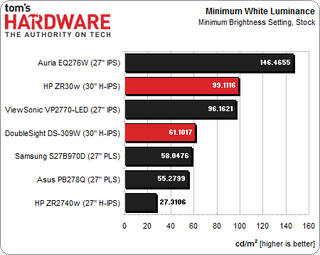
The minimum output level of both panels still provides a very usable image. If you like to work or game in a totally darkened room, these screens will allow for a good degree of comfort to the eye. Detail and color saturation are retained as well.
Some of our recently-tested monitors achieve absurdly low black levels when the brightness is reduced.
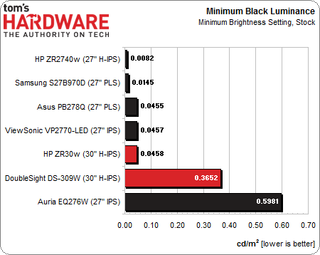
The ZR30w follows suit by measuring a very black 0.0458 cd/m2. DoubleSight's DS-309W, however, only drops 19 percent to 0.3652 cd/m2. The difference is barely visible to the eye. No matter where the contrast control is set on the DS-309W, the black level is about the same.
Along with low black levels come high contrast ratios. If you like to use your computer in the dark, this can often be the best way to achieve maximum image depth.
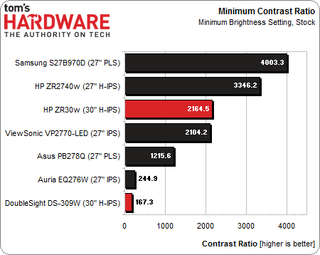
The HP’s contrast ratio doubles to 2164.5:1 at the minimum brightness setting. Because of its relatively high black level, the DoubleSight’s number drops to 167.3:1. Even though color and detail are still OK, the image looks washed out at these settings. For best results, we recommend keeping the DS-309W’s output setting above 100 cd/m2.
Current page: Results: Stock Brightness And Contrast
Prev Page Measurement And Calibration Methodology: How We Test Next Page Results: Calibrated Brightness And Contrast
Christian Eberle is a Contributing Editor for Tom's Hardware US. He's a veteran reviewer of A/V equipment, specializing in monitors. Christian began his obsession with tech when he built his first PC in 1991, a 286 running DOS 3.0 at a blazing 12MHz. In 2006, he undertook training from the Imaging Science Foundation in video calibration and testing and thus started a passion for precise imaging that persists to this day. He is also a professional musician with a degree from the New England Conservatory as a classical bassoonist which he used to good effect as a performer with the West Point Army Band from 1987 to 2013. He enjoys watching movies and listening to high-end audio in his custom-built home theater and can be seen riding trails near his home on a race-ready ICE VTX recumbent trike. Christian enjoys the endless summer in Florida where he lives with his wife and Chihuahua and plays with orchestras around the state.
-
vmem "And for those who demand a density above 100 pixels per inch and a tall 16:10 aspect ratio, they represent the top of the heap...for now"Reply
Isn't the ASUS PQ321 already out along with a few other 4K monitors? granted price is a whole other story -
Marcus52 The lack of an OSD makes the ZR30w a much better gaming monitor, as the OSD causes higher lag. Personally I have no problem doing without one.Reply
You seriously can't see the pixels? I can see them on a 27" 2560x1440, which has smaller pixels. The .25mm range is adequate to me, but really I'd prefer something smaller than the .233mm on the 2560x1440. -
x2ruff4u You guys should wait to get any IPS screen. 60HZ is all they come in & tbh 60HZ in terms of technology is old. I would wait to get a 120HZ IPS monitor because it REALLY makes a difference. Sure you can OC your monitor, but most only go up to 90HZ and that can put a toll on it and eventually fry it. Your best bet is to get a 120hz-240hz TV and if your worried about MS don't be. Compared a low MS to a higher HZ there is very little difference in tech terms (read up about it) This year or beginning of next year WE should be getting some nice monitors you can be proud you spent your money. Hell ASUS already has a 4K monitor and I bet money on 4K monitors by mid-end next year.Reply -
Onus Troll post(s) deleted.Reply
When considering something like this for games, don't forget the cost of the video card(s) needed to drive it. A HD7750 may be "sufferable" even up to 1920x1080, but I'm not sure even a HD7770 or GTX650Ti could play newer games on better than "low" settings on one of these.
-
kungpaoshizi How the heck did you get those numbers via the input pcb for input lag?Reply
I have a ZR30W myself, and I would NEVER trade it unless what I'm upgrading to has more than a 2560x1600 resolution.
I've played on all sorts of monitors, and resolution trumps all other specs, unless you're dealing with 30fps or something...
I really wish I would have spent 1200$ on it long ago. Battlefield 3 and other highly graphical games are comparable to nothing else in the world. -
kungpaoshizi Oh btw, I run BF3 high/ultra settings with a GTX 570 oc'd, and it's peachy enough I don't tell my g/f I'm taking my other 570 out of the machine she's using to hook up SLI again...Reply
The 60hz is not "old tech", it's more than sufficient to run games smoothly if vertical sync is on (even still when it's off). 60 fps is fine, television (pre hd) was 28hz. Anything above 60fps you really don't notice too much.
Oh, and for those looking for 4k tv's to use (I'm way ahead of ya) they only have 30hz refresh rates over the HDMI 1.2 port. We're going to have to wait for the tv's to add another port, wait for the upgrade to HDMI 2.0, or wait for some other solution. -
hero1 I can safely say that I will sit tight and wait for the 4K monitors to hit the market at a reasonable price and grab one as long as they come in at 60Hz or 120Hz and not 30Hz.Reply -
RedJaron It's a shame manufacturers treat 16:10 ratio as a rarity. A decent 1080p is often a little cheaper than a smaller 1680x1050 display and half as much as a slightly larger 1920x1200. Personally I can't stand a 16:9 for a computer. It's fine for TVs and watching media, but to work on I have to have that extra height.Reply -
hero1 Reply11058091 said:It's a shame manufacturers treat 16:10 ratio as a rarity. A decent 1080p is often a little cheaper than a smaller 1680x1050 display and half as much as a slightly larger 1920x1200. Personally I can't stand a 16:9 for a computer. It's fine for TVs and watching media, but to work on I have to have that extra height.
We aren't going to see many 16:10 in the future. the 4K stuff is going to be 16:9 unless someone makes the move to stick with 16:10. However, the difference when it comes to 16:9 with a 2560x1440 and 16:10 2560x1600 is very minimal unless you really really need that extra height!
Most Popular

